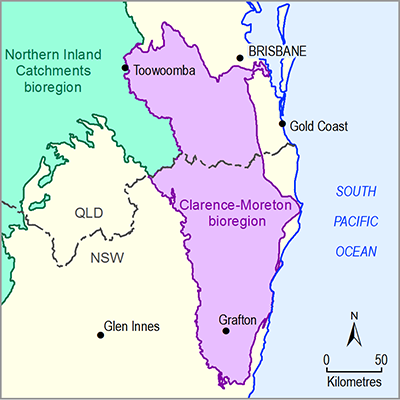- Home
- Assessments
- Bioregional Assessment Program
- Clarence-Moreton bioregion
- 2.1-2.2 Data analysis for the Clarence-Moreton bioregion
- 2.1.2 Geology
- 2.1.2.3 Statistical analysis and interpolation
- 2.1.2.3.4 Representation of structural elements in the three-dimensional geological model
Geological structures such as faults can have a significant influence on groundwater flow. They can, for example, lead to compartmentalization of aquifer/aquitard systems or form preferential pathways for inter-aquifer connectivity (discussed in companion product 2.3 for the Clarence-Moreton bioregion (Raiber et al., 2016)).
In the three-dimensional geological models of the Clarence-Moreton bioregion, knowledge related to the presence of major structural elements has been used to inform the geometry of depositional centers such as the Casino Trough and Grafton Trough. For this purpose, major faults were imported into the three-dimensional model framework as surfaces and this was particularly useful to guide the placement of additional control points to avoid model artefacts in areas of poor data density.
However, modelling vertical displacements (i.e. juxtaposition) of stratigraphic units along faults is associated with many challenges; even in data-rich sedimentary basins such as the linked Surat Basin (and despite more than 10 years of on-going research by many stakeholders), no adequate publicly available basin-wide faulted three-dimensional geological model currently exists.
Key challenges that are associated with the inclusion of faults in basin-wide three-dimensional geological models are:
- Limited or inadequate fault mapping
- Lack of data and understanding on the three-dimensional structure, dip, depth, throw and displacement of faults to inform the model
- Conceptual uncertainties on the role of faults: evaluation of existing data reveals considerable remaining ambiguity, suggesting that there is considerable conceptual uncertainty. This uncertainty is unlikely to be resolved by a single structural model, and this highlights the need to develop multiple structural models (as suggested, for example, by Ye et al. (2010)).
- Computational time: the integration of alluvial, volcanic bedrock and sedimentary bedrock hydrostratigraphic units in the Clarence-Moreton three-dimensional geological models results in very long computational times; the inclusion of faults adds considerably to computational run times.
With the exception of the central Richmond river basin, the density of deep wells with good stratigraphic records and the coverage by seismic surveys is relatively poor in most parts of the Clarence-Moreton bioregion (Figure 9 and Figure 12) compared to other sedimentary basins such as the linked Surat Basin. Furthermore, fault mapping particularly in the Queensland part of the Clarence-Moreton bioregion is extremely limited. This means that for most areas within the Clarence-Moreton bioregion, there are insufficient data to model fault displacements. The only area where there may be sufficient data to develop a faulted three-dimensional geological model is the Richmond river basin. As a result of these challenges and within available time and resources, no faulted three-dimensional geological model could been developed.
To further enhance the understanding of the hydraulic role of faults, the impact of faults on predictions in the context of regional groundwater modelling will be modelled stochastically as part of a CSIRO strategic project for the central Richmond river basin (‘Next generation methods and capability for multi-scale cumulative impact assessment and management’; sub-theme ‘Tracer-based improvement of groundwater model conceptualisation and predictability’).

Product Finalisation date
- 2.1.1 Geography
- 2.1.2 Geology
- 2.1.2.1 Methods
- 2.1.2.2 Observed data
- 2.1.2.3 Statistical analysis and interpolation
- 2.1.2.3.1 Three-dimensional geological model workflow
- 2.1.2.3.2 Definition of the stratigraphic column
- 2.1.2.3.3 Selection of input datasets
- 2.1.2.3.4 Representation of structural elements in the three-dimensional geological model
- 2.1.2.3.5 Characterisation of binding horizons of shallow aquifers (alluvium and basalt)
- 2.1.2.3.6 Characterisation of the bedrock stratigraphic units in the Clarence-Moreton bioregion
- 2.1.2.3.7 Isopach maps, depth to formation top and depth to base of formation
- 2.1.2.4 Gaps
- References
- Datasets
- 2.1.3 Hydrogeology and groundwater quality
- 2.1.4 Surface water hydrology and water quality
- 2.1.5 Surface water – groundwater interactions
- 2.1.6 Water management for coal resource developments
- Glossary
- Citation
- Acknowledgements
- Contributors to the Technical Programme
- About this technical product
